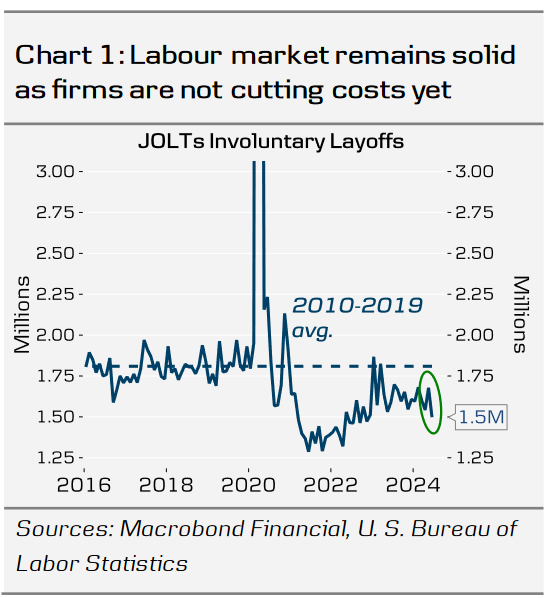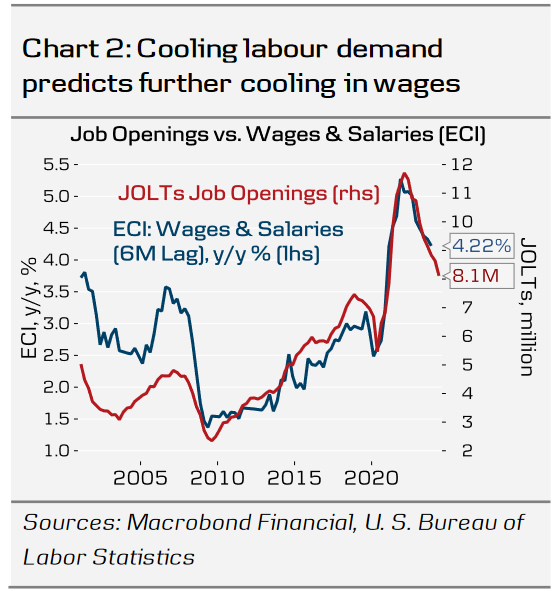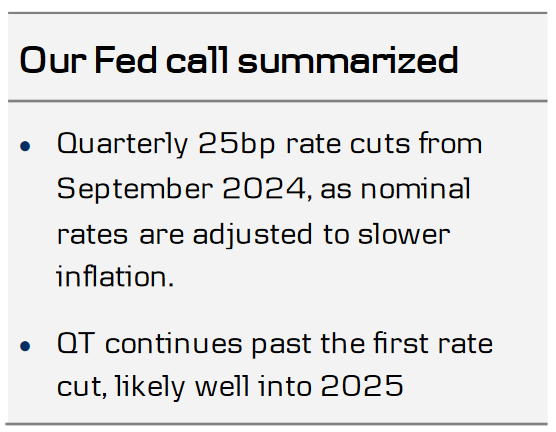- The Fed made no changes to its monetary policy in the July meeting, as widely anticipated. Powell avoided pre-committing but firmly opened the door for initiating rate cuts in September.
- The Fed sees plausible scenarios ranging from ‘zero to several cuts this year’. Focus is on the risk of sharp deterioration in labour market conditions, but we see no reason for panic yet.
- Markets price in a 10-15% probability for a 50bp move in September and a cumulative 72bp of cuts by year-end. We still expect only quarterly 25bp reductions from September and forecast downside potential to EUR/USD.
Powell made it as clear as possible that the September cut is firmly on the table. Already the initial statement noted that ‘job gains have moderated’ (prev. ‘remained strong’) and that ‘Committee is attentive to risks to both sides of its dual mandate’ (prev. only ‘inflation risks’).
During the press conference, Powell noted several times that the Fed has become more mindful of downside risks with regards to the labour market, but also reaffirmed that the economy is ‘actually in a good place’ for now – and we would agree.
The Fed has reached a point where there is no longer uncertainty over whether or not the current policy is restrictive. Economic growth is slowing and labour market conditions have cooled notably. Upside risks to inflation prevail, but Q2 data has increased the policymakers’ confidence on price pressures moderating further.
Powell emphasized that the outcome space for rates remains wide. He saw plausible scenarios ranging from ‘zero to several cuts this year’. We have called for 25bp rate cuts in September and December, followed by four more in 2025, which is now already firmly on the hawkish side of current market pricing.
So why don’t we believe in rapid cuts? Simply put, we still think the economy remains on a solid footing. In our Fed preview, 25 July, we discussed why firms are not yet under pressure to start cutting costs abruptly, and how fiscal policy helps to keep growth afloat. This week, the latest JOLTs data supported that view as firms’ involuntary layoffs fell to the lowest level since November 2022.
Is there a risk that the Fed is falling behind the curve? Yes, but for now the evidence is lacking. Powell humbly noted that gauging the perfect time for initiating cuts is inarguably tricky. We have for long argued that as real interest rates remain restrictive and as inflation continues to cool, the Fed will need to start lowering nominal policy rates to avoid overtightening its policy. Today’s ECI data showed further moderation in underlying cost pressures and leading indicators point towards further slowdown over the coming 6M. For now, the speculation about looming cuts and the consequent easing in financial conditions have helped to ease some of the restrictive effect even when the actual cuts are still in the horizon. The Fed remains mindful of risks, but not in panic mode for now.
Markets: We think the current Fed cut pricing is excessive
The dovish signals from Powell at today’s conference added to the existing market narrative that Fed is set to ease aggressively. Money markets are now pricing 156bp worth of rate cuts over the next 12 months, up from 150bp prior to the statement release. EUR/USD moved lower during the press conference, but reversed part of the decline later on. The US Treasury curve bull-steepened, with the 10Y tenor declining by 6bp to a new 5-month low of 4.07. The current Fed pricing seems optimistic, and we believe that risks related to US rates are now strongly tilted to the upside (see Yield Outlook – Optimism has become excessive, 31 July).
















